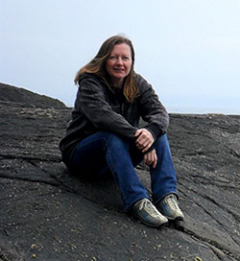Kathy Runnalls

BSc (McMaster); MSc (British Columbia); PhD (British Columbia) Climatology, Physical Geography
Office: N3419B (New Westminster), B3187 (David Lam)
Phone: (604) 527-5782 (New Westminster), 604-777-6008 (David Lam)
Fax: (604) 527-5316
Email: runnallsk@douglascollege.ca
My fascination with the physical environment began early in life, having grown up on a farm in northern Ontario. My playground consisted of the endless streams and lakes on the glaciated Canadian Shield. With extremes of long, bitterly cold winters, to heat, humidity, and spectacular thunderstorms in summer, weather was always top of mind. Witnessing the repeated the 'boom-and-bust' cycles of the resource based economies of the area also instilled in me an appreciation of the interconnectedness of people and their physical environments. So it seems inevitable that I would end up studying geography.
As an undergraduate student, I worked as a research assistant in geography and geology, and this experience convinced me to pursue my studies at the graduate level. So I moved across the country to the west coast, which presented a whole new environment to become enamoured with. My graduate work focused on urban climatology. I am particularly interested in how modification of natural surfaces affects energy exchanges and the resulting microclimates, especially in the context of interpreting historical temperature records and climate change.
I began teaching geography as a graduate student, and quickly realized that this would become my career. I joined the Geography and the Environment Department at Douglas College in 2000. I teach introductory weather and climate (Geog 1110), earth sciences (Geog 1120), climatology (geog 2210), quantitative methods (geog 2251), and regional geography of BC (Geog 1160) and Canada (Geog 1180). I try to emphasize hands on learning by encouraging students to get outdoors, make their own observations, and to critically analyze their results. I hope that my students not only develop their understanding and appreciation of the physical environment, how it affects- and is affected by- their day-to-day activities, but that they also develop problem solving and critical thinking skills that they can apply to any learning situation.
Publications
Runnalls, K.E. and T.R. Oke (2006): A technique to detect microclimatic inhomogeneities in historical records of screen-level air temperature. Journal of Climate 19, 959-978.
**Runnalls, K.E. and T.R. Oke (2000): Dynamics and controls of Vancouver's near-surface urban heat island. Physical Geography, 21, 283-304.
Davies, J.A., P. Kuhn, G. DuHamel J. Binyamin, and K. Runnalls (2000) An ultraviolet (290 to 325 nm) irradiation model for southern Canadian conditions. Physical Geography 21, 327-344.
Runnalls, K.E. and T.R. Oke (1998): The urban heat island of Vancouver, British Columbia in Preprints, 2nd Urban Environment Symposium, American Meteorological Society, Albuquerque NM, November 1998.
Porat, N., H.P. Schwarcz, E. Tchernov, D. Braun and K. Runnalls (1992): The chronostratigraphy of the tool-bearing layers at Oumm Qatafa Cave (Judea Desert) revisited. Annual Meeting, Israel Geological Society, Ashqelon, Israel, March 30-April 1, 1992. 116-117.
**This paper is not available on-line. If you would like a copy, please email me.